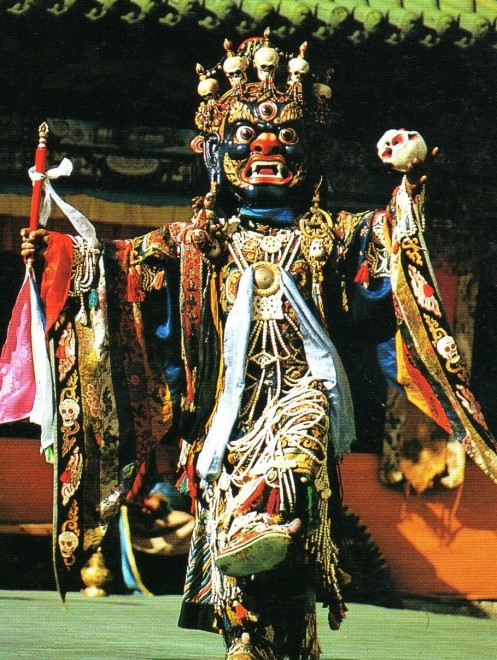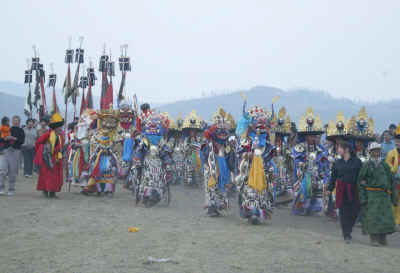
A Tsam
ceremony was held at the beginning of the year to
exorcise evil. It consisted of a series of masked
dances and often had a narrative content. Tsam means masked dance, and
local variations of the festival were once practiced in
Tibet, Ladakh, Nepal, Sikkim, Bhutan, China and
Mongolia, but only in Ladakh and Bhutan and at a few remote,
inaccessible monasteries has it been protected from destructive
politics and the impact of Western civilization. In
Tibet, Mongolia, Transbaikalia, and China the festival
either fell victim to the ruthless Stalinist
suppression of Buddhism in the 1930s, or more recently
to the vandalism unleashed by the Chinese Cultural Revolution
of Mao Zedong. Today in Mongolia efforts are being made to revive
the tradition, with elderly monks who survived
persecution teaching young monks the rituals and
choreography of Tsam.

While the use of grotesque masks in the Tsam dances creates an impression of going back to high antiquity, the festival is in fact a relatively recent tradition. Among the southern Mongol tribes, the annual dance seems to have been adopted during the second half of the eighteenth century. At the capital of Urga (near present-day Ulan Baatar) it is said that these dances were first performed in the monastery of Bogdo Gegen (“Living Buddha”) in 1811.

While the use of grotesque masks in the Tsam dances creates an impression of going back to high antiquity, the festival is in fact a relatively recent tradition. Among the southern Mongol tribes, the annual dance seems to have been adopted during the second half of the eighteenth century. At the capital of Urga (near present-day Ulan Baatar) it is said that these dances were first performed in the monastery of Bogdo Gegen (“Living Buddha”) in 1811.
There is an old Tibetan legend saying that long ago there were two ascetic Buddhist monks, who would meditate so profoundly, they'd lose all contact with the outside world. One such time - being lost in a deep state of meditation - they were caught unaware by a thief and beheaded; therefore they did not realize [immediately] they had died. The two became the Lords of the Cemetery, dancing an ecstatic Tsam dance - an eternal dance of death.











Hiç yorum yok:
Yorum Gönder